WWV, the time station from NIST, located in Fort Collins, CO entering the New Year. With added silent leap second and odd tone for the 00 second.
WWV 2009 New Year900kB MP3. Recorded with a Degen 1103 and straight audio recording (no cable).
Wednesday, December 31, 2008
Tuesday, December 30, 2008
Mirach's Ghost
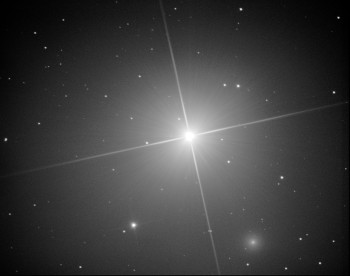
NGC 404 near Mirach. Click to enlarge
Continuing my Black Friday imaging blitz, I came across this galaxy while recalibrating the telescope's setting circles on Mirach, a bright star in Andromeda. I was making sure they were as accurate as possible while heading to the quasar 3C 48. On such a bright star a CCD image will show beautiful diffraction spikes and a gradient of grays that to me are nearly the best thing out there. So while taking some images for that one of the stars looked a bit fuzzy, and sure enough NGC 404 popped out. Phil Plait has a nice post about it, and that post was the push to complete this round of processing.
Friday, December 26, 2008
The Bubble Nebula
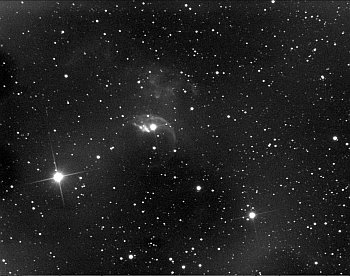
The Bubble Nebula in Cassiopeia. 22 minutes total exposure. Click to enlarge.
Continuing the long streak of images acquired in late November, this is the Bubble Nebula, NGC 7635. The fast stellar wind emanating from the bright Wolf-Rayet star in the Bubble meets the slow gas of the surrounding nebula to make the shock wave that is the Bubble. The Bubble itself is a very faint object--and clearly more exposure is needed to bring out the fainter parts of the Bubble. There is an area of denser molecular gas and dust just to the left of the star, resisting the stellar wind and UV radiation of the star at the moment, but evaporating still the same.
For a Hubble Space Telescope shot of the Bubble, click here.
Truth and media reports: Chicago fog
Kristyn Hartman wasn't trying too hard on her "live" report for the 10 o'clock news report for WBBM Channel 2 in Chicago, about the fog stopping all flights at Midway. As she reported live from the top level of Midway, you could see the parking garage off in the distance--indicating the bad fog had lifted, even while she says "As you can see, because of the thick fog...". At the worst of the fog, it was in fact a few hundred feet visibility, as they had been reporting, as they were interviewing and getting the stock shots. But they should have admitted the fog had lifted at the time of the live report, as the parking garage is over 3000 feet from the location of the live report. Sloppy reporting. Even just a few minutes after the live report, Ed Curran the meteorologist was reporting visibility was a full mile at Midway.
P.S. This isn't to disparage the seriousness of the fog this evening. It was very dense this evening. But it wasn't dense at the moment of the live report, and that's all I'm trying to write.
P.S. This isn't to disparage the seriousness of the fog this evening. It was very dense this evening. But it wasn't dense at the moment of the live report, and that's all I'm trying to write.
Thursday, December 18, 2008
Surplus Shuttles available
Billion dollar technology available for only $42 million! Alas, there are requirements, like indoor storage and no private launching.
Register: NASA will give away old Shuttles for free
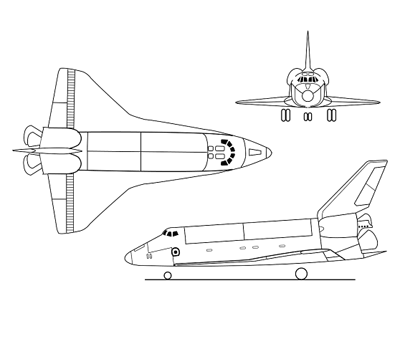
Register: NASA will give away old Shuttles for free

Wednesday, December 17, 2008
a very simple 2.4GHz meter
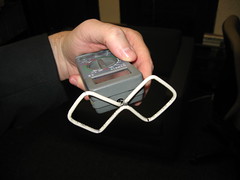
I built a very simple meter that reads the strength of radio energy in its vicinity, without amplification or anything fancy. It picks up radio waves roughly around 1 to 3 gigahertz. It does very well in detecting cell phones, microwave ovens, and wireless access points.
On a simple level, the antenna converts radio waves into an electrical AC voltage, which is then converted by the germanium diode into a pulsing DC voltage. A capacitor stores the pulses and smooths out the pulsing and leaves a very small DC voltage, which is measured directly at a tiny multimeter I picked up at American Science and Surplus. I set the meter to DC voltage, 200mV scale.
The biquad antenna is sensitive to vertically polarized waves and slightly directional as well. A lot of designs also stick a ground plane behind it to increase the directionality, but I was looking for more of a field strength probe, rather than having an antenna that got me the most gain. It's a trade-off since the detector is so simple and without amplification, but that's what you get.
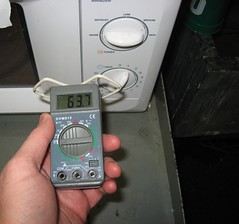
What can we measure with this meter? My standard test suite for gigahertz-ish radio frequencies is delinquent*, so all I can think of is cell phones, microwave ovens, and wireless networking. I found that the office microwave oven puts much more energy out at the hinge side of the door and a fan vent on the side than it does the meshed window. It can saturate the meter at the 200mV scale (when right next to the fan vent). Cell phones periodically check in with their towers (you can also tell this with a set of computer speakers anywhere near a GSM phone). They also do put out a bit of gigahertz radiation; I can detect them sending text messages from about six feet away and more when talking--they can also reach 200mV. Wireless 802.11b and g networks are actually pretty low-power in the scheme of things--they hard to see except close-up until they are transmitting data; then I can detect them six or so feet away. During idle they emit a "beacon" 10 times a second. The wifi antennas are also a good source for checking the polarization of the biquad--I get nearly nothing from them if I rotate the receiving antenna 90 degrees.
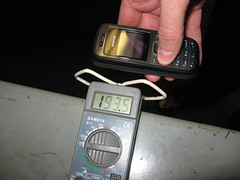
Outside the signal level varies greatly. There is a pervasive field which is presumably cellular networks and the addition of all the 802.11b/g/n networks. On the University of Chicago campus near the Regenstein Library the average strength varies from 0.2mV to 0.6mV, with a couple of spikes to 1.0mV. There are also areas of much stronger than ambient. For instance, outside of the Medici on 57th street the average field strength is 2-3mV and peaks at moments at 8mV. There are cellular tower antennas on a school across the street; so it seems likely the area is getting a particular sector of the tower.
I used this Field Strength Meter for 2.4 Ghz Wireless LAN as the excellent template for the project. For my version I used a standard 1N34A germanium diode--this is a more sensitive diode, and turns on at 0.3V instead of 0.6V like a standard silicon diode. I painted the diode black, as the diode proved to be photo-sensitive (all PN junctions are light-sensitive, and ones in transparent glass tubes even more so). Also, I didn't tune the capacitance at all. I then ran two wires to the inside plugs and drilled a hole in the case and hot-glued the antenna to the front of the meter. It's nice and compact, although the GP23A 12V battery in it doesn't last very long.
I could see easy modifications of this system, putting a simple FET amplifier or such to increase the meter response. If I use one of the inexpensive multimeters from Harbor Freight I might have enough room for a prebuilt circuit and a more directional antenna. I'd also like to see if I can pick up both aviation and weather radars with such a simple system. Maybe I should make a Sardine Can antenna?
*delinquent is also a synonym for nonexistent.
Thursday, December 11, 2008
Tuesday, December 09, 2008
Uranus and three of its satellites: Ariel, Titania, and Oberon
As part of that Black Friday imaging blitz, I took a look at Uranus. In contrast to a set of images I took some eight years ago (see below), Uranus is now experiencing an equinox--its equator is now pointing towards the inner Solar System. You might remember that in contrast to the rest of the planets, Uranus and its satellites are tilted nearly ninety degrees off of the ecliptic, leaving each hemisphere to experience 21 year long summer and winters. The long slumber of cold is over for one pole and the light is fading for the other. And, since the moons' orbit in the plane of the Uranian equator, they mutually transit and occult each other for a time period during the equinox. As we orbit quickly in the warm inner solar system the plane of the satellites appears to wobble back and forth from Earth's motion. The period of mutual events is coming to a close, with only three left, and the seasons will become definitive on Uranus.
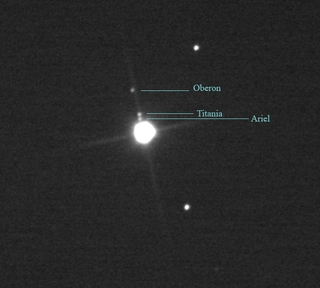
Uranus and three of its satellites: Ariel, Titania, and Oberon. 88x5second exposures. Click to enlarge.
Satellites identified via the Solar System Simulator.
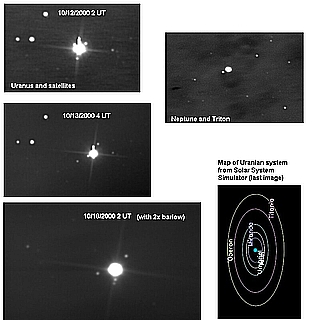
A series of images taken long ago on a 382x240 pixel CCD!. Click to enlarge.

Uranus and three of its satellites: Ariel, Titania, and Oberon. 88x5second exposures. Click to enlarge.
Satellites identified via the Solar System Simulator.

A series of images taken long ago on a 382x240 pixel CCD!. Click to enlarge.
Thursday, December 04, 2008
Quasar 3C48
It was clear on the Friday after Thanksgiving, so I spent a long evening imaging some neat targets.
The first was the quasar 3C 48 in Triangulum, one of the first to be identified as such--as a "quasi-stellar object", a radio source coming from an apparently point source, and yet stronger than any radio emissions previously identified from stars.
In 1960-62, using two radio telescopes in Owens Valley, astronomers Thomas Matthews and Allan Sandage were able to zero in on the location of the radio source to within 10 arcseconds, and the only object in the field was a 16th magnitude "star". And for two years, they noted its optical variability, its lack of any motion across the sky, and a very faint nebulosity associated with it, with a non-descript spectra. And yet, the QSO remained to the astronomers studying it only a potentially Milky Way object, something obviously further than "close" in the galactic sense, but far enough away to be stellar in appearance and non-moveable.
After submitting a paper about three of these objects in 1963, Matthews and Sandage get word that Schmidt has discovered that another QSO has a significant redshift (which is published in Nature in March 1963), and this allows them the scientific freedom to reinterpret their own spectra as a high-redshift spectrum of z=0.367.
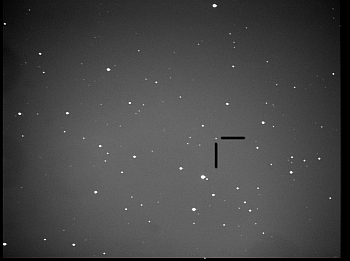
22 minutes total exposure, Click to enlarge. 10-inch f/6 reflector and Starlight Express SXV-H9 camera
Here's another CCD image from Anthony Ayiomamitis of the quasar.
The first was the quasar 3C 48 in Triangulum, one of the first to be identified as such--as a "quasi-stellar object", a radio source coming from an apparently point source, and yet stronger than any radio emissions previously identified from stars.
In 1960-62, using two radio telescopes in Owens Valley, astronomers Thomas Matthews and Allan Sandage were able to zero in on the location of the radio source to within 10 arcseconds, and the only object in the field was a 16th magnitude "star". And for two years, they noted its optical variability, its lack of any motion across the sky, and a very faint nebulosity associated with it, with a non-descript spectra. And yet, the QSO remained to the astronomers studying it only a potentially Milky Way object, something obviously further than "close" in the galactic sense, but far enough away to be stellar in appearance and non-moveable.
After submitting a paper about three of these objects in 1963, Matthews and Sandage get word that Schmidt has discovered that another QSO has a significant redshift (which is published in Nature in March 1963), and this allows them the scientific freedom to reinterpret their own spectra as a high-redshift spectrum of z=0.367.

22 minutes total exposure, Click to enlarge. 10-inch f/6 reflector and Starlight Express SXV-H9 camera
Here's another CCD image from Anthony Ayiomamitis of the quasar.
Subscribe to:
Comments (Atom)
